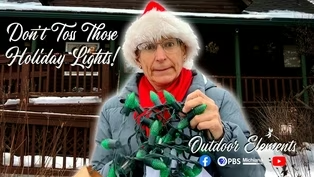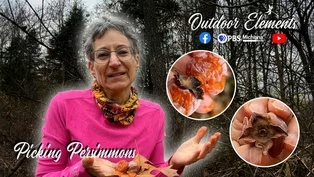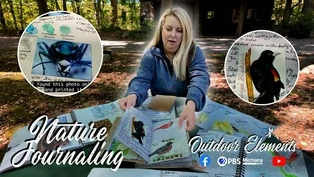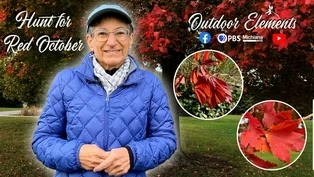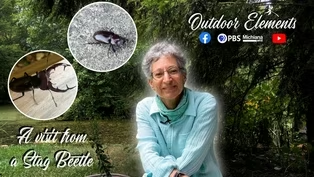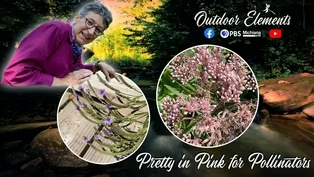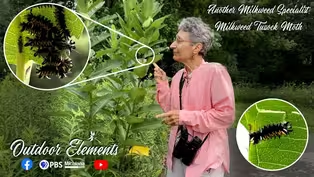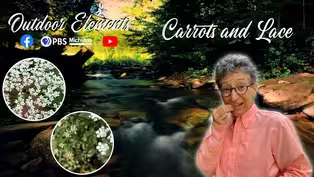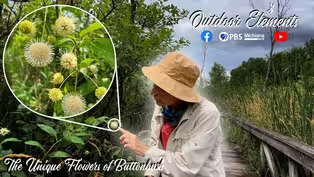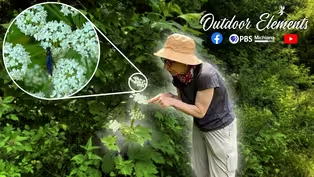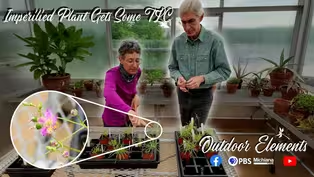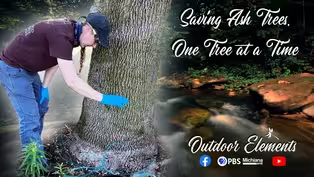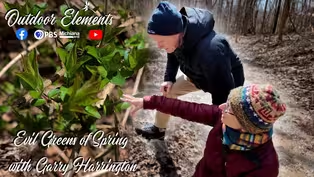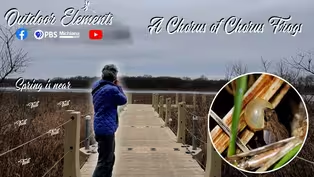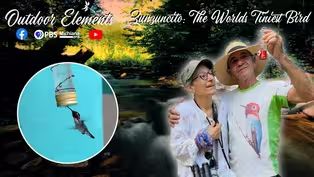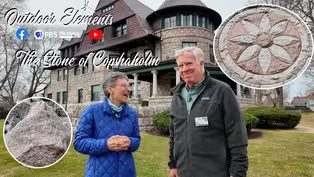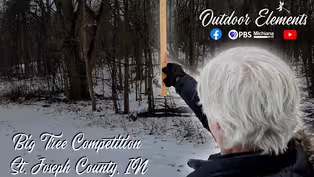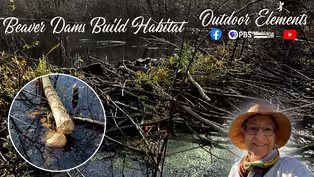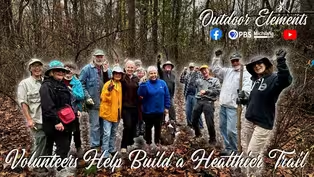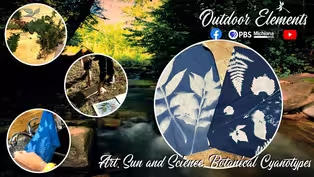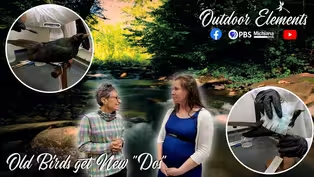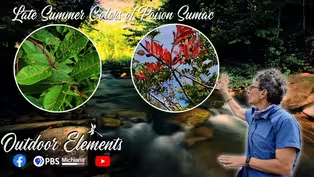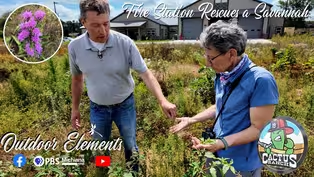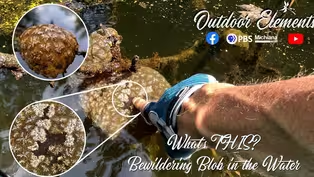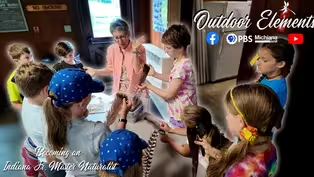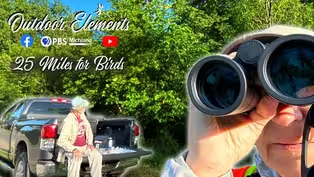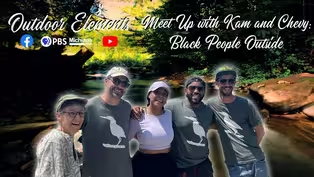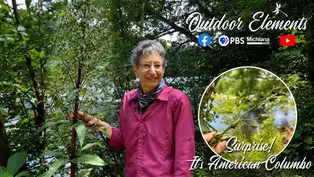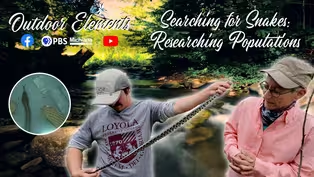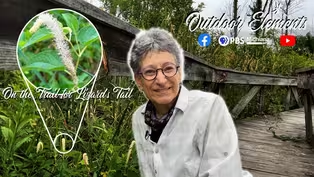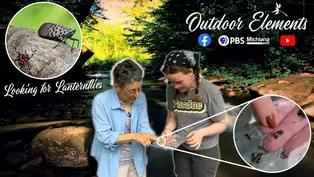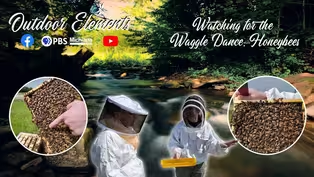Outdoor Elements
Nature Journaling
Clip | 11m 50sVideo has Closed Captions
🌿🖊️ It’s time to slow down and connect with nature! In this episode of Outdoor E
🌿🖊️ It’s time to slow down and connect with nature! In this episode of Outdoor Elements, Deanna Varela from St. Joseph County Parks walks us through the art of Nature Journaling. 🌳✨ Discover what you need to get started and explore all the creative ways to fill your journal — from sketches and photos to poetry and personal reflections. It’s all about getting ...
Problems playing video? | Closed Captioning Feedback
Problems playing video? | Closed Captioning Feedback
Outdoor Elements is a local public television program presented by PBS Michiana
Outdoor Elements
Nature Journaling
Clip | 11m 50sVideo has Closed Captions
🌿🖊️ It’s time to slow down and connect with nature! In this episode of Outdoor Elements, Deanna Varela from St. Joseph County Parks walks us through the art of Nature Journaling. 🌳✨ Discover what you need to get started and explore all the creative ways to fill your journal — from sketches and photos to poetry and personal reflections. It’s all about getting ...
Problems playing video? | Closed Captioning Feedback
How to Watch Outdoor Elements
Outdoor Elements is available to stream on pbs.org and the free PBS App, available on iPhone, Apple TV, Android TV, Android smartphones, Amazon Fire TV, Amazon Fire Tablet, Roku, Samsung Smart TV, and Vizio.
Providing Support for PBS.org
Learn Moreabout PBS online sponsorshipHi everybody, I'm Diana.
I am an interpretive naturalist at the Saint Joseph County Parks.
And today I'm going to be talking to you about nature journaling.
I got my start nature journaling when I first moved to this area, four years ago, I took a course, fell in love with nature journaling because I love to write and make sketches.
Be out in nature.
I have since also taken a course and I'm becoming a certified as an educator for nature journaling.
In the meantime, I have taught nature journaling to middle schoolers.
And I've also taught an adult workshop.
I'm currently teaching a ten week course for seniors, all with beginners in mind.
Nature journaling, 101.
So the curriculum I like to use is by John Muir Laws.
If you're looking for the Bible, so to speak, of nature journaling, you might want to check out his book, The Laws Guide to Nature Drawing and Journaling.
It's a fantastic book with everything you could ever want to know and learn about nature.
Journaling.
Of course, there's many great books out there.
If this one's too heavy for you and you want to start with something lighter, there's many authors out there with nature journaling books.
The bare minimum that someone would need to nature Journal would be a simple piece of paper and a pencil.
With my courses and my workshops, the parks do supply a simple journal, a craft paper, outer and simple pages that are kind of thin, but they actually do take some watercolor pretty well.
If you use a light coat.
But again, all you really need for nature journaling is a pencil and one sheet of paper.
Nature journaling is not just about making art.
As a matter of fact, it's not about the art at all.
You do not have to be an artist to nature journal.
You just have to have the interest in being outdoors and being inquisitive, taking time to slow down and be and wonder and awe of what's around you.
Nature journaling helps you to document those moments in nature that you may want to remember later or refer back to.
For example, if you say, I don't like to draw, I'm not an artist and that's too much stress for you.
You can just write.
You could write poetry.
You could write a description of the day.
If you're more scientific, you could actually take things and break them down to study them.
For example, today with my students, we actually dissected a flower and named all the parts and studied it.
And it was very educational, but also a fun activity.
So your writing can be anywhere from, again, just your thoughts of the day and the place that you are.
Poetry, and even scientific writing.
I've even used the lyrics from songs in some of my journals.
For example, I know that this is not a regular blackbird, but I did use the Beatles song as lyrics for the black.
The background excuse me for the Red wing Blackbird.
So people have pointed out that's not the blackbird they met in the song, but that's okay, because nature journaling is what you want to make it.
There are no rights or wrongs as you can also see, I have drawn and painted some photos and torn them out of other paper and put them in here.
Because I had this journal, I didn't know what to do with, so I made it more like a scrapbook.
You can even use pen.
This is called washi tape to put your items in, and then you can go back and if you want to put your thoughts in, if you want to study the plants that you've looked at, you can do that as well.
This is just another loose leaf, one that I did of a flower at a botanical garden.
You can also take photographs, and if you want to take more time to draw or study the plants or animal, you can take photographs of the event.
You can find photos online or even in magazines, and you can draw from those.
You could even collage with photographs.
You don't have to make it about making art at all other than collage.
Another thing, I really love photography.
So what I have done also is I have a mini printer, so I've taken photos with my phone and then printed these out with the mini printer.
This is just a miniature Polaroid.
You might remember the old school Polaroids back in the 80s, maybe the 70s.
These are kind of modern miniature Polaroids that you can also take photos with.
You may have a title of your journal.
I did some colors just with watercolor to try to color match this bug.
I found this photo online and printed it.
You can also document where are you at?
What's the weather like?
The temperature mostly sunny, so on and so forth.
You can even put the sunrise sunset as much detail or not at all that you like.
And when you're nature journaling.
Another thing I love by John Muir Laws is they have something they've created called mini zines.
So these are called zines, short for many zines.
So this one is for anybody who wants to get started in a nature journaling.
You can download this from their website at Wild wonder.org.
It is offered in English, Spanish, Japanese, Chinese, Portuguese and other languages.
So I love that it's also very inclusive for anybody that wants to learn nature journaling.
So as you open it up, it's a little book that will tell you nature journaling is with the definition.
Then it opens up even further the basics that you need words, pictures, numbers.
Like I said, if you're writing scientifically, you might use numbers.
Or let's say you want to learn how to measure a tree.
You're definitely going to use numbers in that scenario.
Think three questions to ask yourself or to say if you don't know what, how, where to start?
How do I start?
I notice, I wonder.
It reminds me of.
Those are three key prompts that anybody can follow to get you started.
If you don't know where to start with your nature journaling tools, the very basic is a pencil and some paper.
If you want to upgrade, you get a little journal.
Maybe you want some measuring tools or some tools to see things up close.
Magnifying glasses, rulers, things like that.
If you want some color added in, you can use colored pencils.
You can use watercolor paint.
I've even used color pen.
So if you like to add a little bit of color, those are some unique ways to do that.
And they don't have to be expensive.
Don't buy expensive products, use whatever you have around the house or that you can find on sale at Dollar Tree or another big box store.
Places to journal I think a lot of people think, well, I'm not going to travel and go to this big, spectacular place to Nature Journal.
Well, you don't have to if you happen to be in a spectacular place.
Yes.
Nature Journal, but this is also for urban areas, places around your home in the city.
When you're walking down the sidewalk, have you ever seen a dandelion growing between the cracks that might be in an urban area?
There are definitely animals, and insects in urban areas as well.
So there's plenty of things.
Maybe there's it's not a green space, but there might be trees outside of a building.
If you find a tree, you can nature journal about a tree.
So another place is at home.
Often we may not look at our front or backyards in detail, but nature journaling allows you to slow down and notice these things and take time for yourself.
It's very relaxing and many studies show you, as you may or may not know, being in nature improves mental health and lowers blood pressure and causes people well, not causes.
But people are happier when they spend more time outdoors.
If you can't get outdoors because of the weather, winter time is also a great time.
You can simply be in more in your warm house with your cozy drink, looking out the window, watching some winter animals.
There's several winter birds that stay in our area during, cold seasons, so there are things you can journal.
Even the snow, or perhaps squirrels playing in the snow.
When I open this little mini zing up, it actually has more prompts inside.
So these if for lack of a better term, you could call them assignments or prompts.
Poetry of place.
This gives you the directions of what to do for poetry and place.
If you want to make a diagram of a piece of fruit.
Another way to nature.
Journal at home.
By using fruits and vegetables, you could do a soundscape mat map.
If you go to the parks and you listen to the sounds that are around you, such as birds or the wind or the leaves falling hidden figures, that would be something like measuring a tree and learning about that.
Zoom in and zoom out.
Perhaps you have looked at acorns or other nuts that have fallen, but have you ever really studied that up close?
Pick those nuts up.
Look at them closely.
Use a magnifying glass.
Notice the details that you may have missed by just walking by or accidentally stepping on them.
The other things are questioning questions.
So if it's if you come up with a question, I wonder what this nut looks like inside.
I've never opened this particular nut that might lead you to ask even more questions.
So your questions be prepared that they're going to lead to more questions, and you can go as in-depth as you like with nature learning comparisons.
Let's say you want to compare two different kinds of leaves.
We did that today where we compared many types of leaves, and we were in awe at what we just found right around this cabin on the ground that we were able to study.
So even things that have fallen off of trees are no longer viable.
Those are the things you want to study.
Try to never pick fresh flowers or leaves off of trees.
Find what's on the ground.
And it's it's almost like a hide and seek game and it can be quite fun.
So as I mentioned before, I am teaching classes here and their workshops on nature journaling and a current course.
What we've also started is a nature journaling club, and we meet the last Saturday of every month at a different park.
So if you watch for our web page or our social media sites, you can find out where you can join the Nature Journaling Club.
It's low pressure.
It's not a full lesson.
You will get a prompt, but it's a nice way to casually learn about and have community.
When nature journaling.
I hope to see you at the parks and join us in nature journaling.
Don't Toss Those Holiday Lights! | OE
Video has Closed Captions
Clip | 8m 25s | 🎄✨ Got holiday lights that no longer sparkle? Don’t toss them! ♻️ In this ep (8m 25s)
Video has Closed Captions
Clip | 3m 38s | 🍂✨ Out on a fall walk in the woods, Evie stumbled upon a sweet seasonal surprise — (3m 38s)
Urban Transformation at Milkweed Gardens
Video has Closed Captions
Clip | 17m 11s | No description (17m 11s)
Video has Closed Captions
Clip | 11m 50s | 🌿🖊️ It’s time to slow down and connect with nature! In this episode of Outdoor E (11m 50s)
Video has Closed Captions
Clip | 3m 20s | 🐔👀 There’s a possum in the hen house! 🐾 On this episode of Outdoor Elements, E (3m 20s)
Video has Closed Captions
Clip | 2m 57s | 🍁 It’s that time of year when nature puts on its most colorful show! 🌳 In this epi (2m 57s)
Video has Closed Captions
Clip | 3m 36s | 🌿🪲One of our awesome viewers spotted a beetle making its way across the driveway and (3m 36s)
Video has Closed Captions
Clip | 3m 24s | A viewer shared a fascinating video of a Paintedhand Mudbug, and Evie dives into the detai (3m 24s)
Pretty in Pink for Pollinators
Video has Closed Captions
Clip | 5m 3s | At Lydick Bog Nature Preserve, Evie spots a burst of pink in a wetland. She explores these (5m 3s)
Another Milkweed Specialist: Milkweed Tussock Moth
Video has Closed Captions
Clip | 4m 36s | No description (4m 36s)
Video has Closed Captions
Clip | 3m 43s | Evie spotted Pointed-leaf Tick-Trefoil and shares how to identify this plant. (3m 43s)
The Unique Flowers of Buttonbush
Video has Closed Captions
Clip | 3m 58s | Evie finds Buttonbush at Spicer Lake Nature Preserve (3m 58s)
Saving Ash Trees, One Tree at a Time
Video has Closed Captions
Clip | 11m 16s | No description (11m 16s)
Bringing Bees Back to the Nature Center
Video has Closed Captions
Clip | 6m 10s | No description (6m 10s)
Gathering for Science: An Environmental Research Symposium
Clip | 10m 27s | Evie stops by the St. Joseph County Public Library during their Earth Day celebration to c (10m 27s)
Surprising Color in the Woods: Blue Stain Fungi
Video has Closed Captions
Clip | 3m 48s | No description (3m 48s)
Maple Sweet Treat for Ants | Outdoor Elements
Video has Closed Captions
Clip | 1m 34s | A sweet surprise in the woods! (1m 34s)
Evil Greens of Spring with Garry Harrington
Video has Closed Captions
Clip | 12m 56s | Things are greening up in the spring woods, but it’s not necessarily a welcome sight. (12m 56s)
Volunteers Help Build a Healthier Trail
Clip | 6m 9s | At Lydick Bog Nature Preserve, volunteers make a big difference in protecting and maintain (6m 9s)
Art, Sun and Science: Botanical Cyanotypes
Clip | 6m 49s | Experimenting with cyanotype fabric brings nature to life in beautiful, sun-printed design (6m 49s)
Clip | 3m 57s | Evie shares a fun and simple craft idea using autumn leaves that the whole family can enjo (3m 57s)
Late Summer Colors of Poison Sumac
Clip | 1m 59s | Watch out for this colorful danger at Lydick Bog Nature Preserve! (1m 59s)
What's THIS? Bewildering Blob in the Water
Clip | 5m 8s | What’s that mysterious blob in the water (5m 8s)
Clip | 7m 14s | Find out how thousands of volunteers help the US Geological Survey teams and other resourc (7m 14s)
Meet Up with Kam and Chevy: Black People Outside
Clip | 5m 18s | Meet the inspiring creators behind Black People Outside. (5m 18s)
Surprise! It's American Columbo
Clip | 5m 14s | Explore the unique features of the American Columbo. Discover its habitat, appearance, and (5m 14s)
Searching for Snakes: Researching Populations
Clip | 13m | Delve into the world of snake population research in northern Indiana and discover the met (13m)
On the Trail for Lizard's Tail
Clip | 3m 10s | We are at @SpicerLakeNaturePreserve to learn about the fascinating plant known as Lizard's (3m 10s)
Clip | 7m 35s | Uncover the impact of the invasive Spotted Lanternfly. (7m 35s)
Clip | 3m 6s | Love it or hate it, that flying white fluff looks like “Snow in June!” (3m 6s)
Watching for the Waggle Dance: Honeybees
Clip | 12m 32s | Join Evie as she interviews Morgan Carr-Markell, Assistant Professor at Saint Mary's Colle (12m 32s)
Providing Support for PBS.org
Learn Moreabout PBS online sponsorshipSupport for PBS provided by:
Outdoor Elements is a local public television program presented by PBS Michiana
